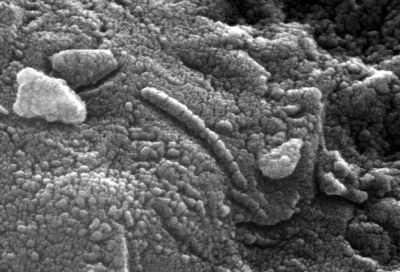Tuesday, December 01, 2009
Life on Mars -- the probability increases.
You may remember way back a little over ten years ago when excited scientists announced they had found the first physical evidence of life on Mars!
Their examination of "Mars rock" -- the Allan Hills 84001 meteorite, which was blasted off of Mars some 15 million years ago to ultimately land in Antarctica -- revealed what sure looked a lot like fossilized bacteria (or "Mars bugs").

The excitement passed a little while later when other scientists announced that they were able to reproduce the same kind of structures in rock using natural processes, without involving living organisms.
But science marches on and the investigation of Allan Hills 84001 continued.
Now NASA has released a new paper (.pdf) summing the results of latest research...
Their examination of "Mars rock" -- the Allan Hills 84001 meteorite, which was blasted off of Mars some 15 million years ago to ultimately land in Antarctica -- revealed what sure looked a lot like fossilized bacteria (or "Mars bugs").

The excitement passed a little while later when other scientists announced that they were able to reproduce the same kind of structures in rock using natural processes, without involving living organisms.
But science marches on and the investigation of Allan Hills 84001 continued.
Now NASA has released a new paper (.pdf) summing the results of latest research...
Life on Mars: New Evidence from Martian MeteoritesAs reported by Timesonline.uk in layman's terms...
New data on Martian meteorite 84001 as well as new experimental studies show that thermal or shock decomposition of carbonate, the leading alternative non-biologic explanation for the unusual nanophase magnetite found in this meteorite, cannot explain the chemistry of the actual martian magnetites. This leaves the biogenic explanation as the only remaining viable hypothesis...
Additional data from two other martian meteorites show a suite of biomorphs which are nearly identical between meteorites recovered from two widely different terrestrial environments (Egyptian Nile bottomlands and Antarctic ice sheets).
This similarity argues against terrestrial processes as the cause of these biomorphs and supports an origin on Mars for these features.
Nasa scientists have produced the most compelling evidence yet that bacterial life exists on Mars.
It showed that microscopic worm-like structures found in a Martian meteorite that hit the Earth 13,000 years ago are almost certainly fossilised bacteria ...
The so-called bio-morphs are embedded beneath the surface layers of the rock, suggesting that they were already present when the meteorite arrived, rather than being the result of subsequent contamination by Earthly bacteria.
“This is very strong evidence of life on Mars,” said David Mackay, a senior scientist at the NASA Johnson Space Centre...
Dennis Bazylinski, an astrobiologist from the University of Nevada who peer-reviewed the findings, said: “Until now I was on the fence but this paper has really thrown out the non-biological explanation”...
The team has also been studying two other Martian meteorites — Nakhla, which landed in Egypt in 1911, and Yamato 593, which was found by a Japanese expedition to Antarctica. In research due to be published shortly, the scientists claim that both of these fossils also show evidence of microbial life...
